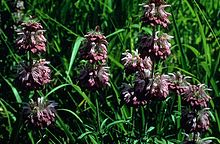Monarda citriodora
| Monarda citriodora | |
|---|---|
 |
|
| Scientific classification | |
| Kingdom: | Plantae |
| (unranked): | Angiosperms |
| (unranked): | Eudicots |
| (unranked): | Asterids |
| Order: | Lamiales |
| Family: | Lamiaceae |
| Genus: | Monarda |
| Species: | M. citriodora |
| Binomial name | |
|
Monarda citriodora Cerv. ex Lag. |
|
Monarda citriodora is a species of flowering plant in the mint family, Lamiaceae, that is native much of the United States and Mexico. Common names include lemon beebalm,lemon mint (this may also apply to Melissa officinalis) and purple horsemint. When crushed, the leaves emit an odor reminiscent of lemons. This odor is sometimes described as more resembling oregano, especially late in the season. Its purple flowers are highly attractive to butterflies, bees and hummingbirds.
Lemon beebalm can tolerate dry soil, and requires little water and direct sun light. Several stems grow from the base and are lined with pairs of lance-shaped leaves. It grows quickly during spring, reaching up to 3 feet high, and blooms its white, purple and pink colored flowers from May through July, continuing to bloom even later in the year if given water. The plant dies with the first frost, and although lemon beebalm is an annual, its seeds can germinate and grow the following year.
This widespread plant grows in prairies, roadsides and other sunny habitats from Arizona to Florida, and from Nebraska to Michoacán. It prefers soils with a high percentage of clay, such as the vertisols and mollisols typical of tallgrass prairies, where it sometimes forms impressive blankets of summer flowers.
Some people use lemon beebalm as an addition to salads and teas. It's also used sometimes in wines and liqueurs. It can give a good flavor to certain seafood and meat dishes too, such as crab and chicken. Lemon beebalm is an ingredient in many dessert recipes, and is used for flavoring in cakes, cheesecakes, sauces, and pies.
...
Wikipedia
